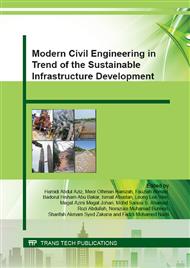p.63
p.71
p.77
p.83
p.89
p.95
p.101
p.107
p.112
An Overview of Non – Engineered Buildings Roofing System Failure under Wind Loads
Abstract:
Strong wind is an annual natural hazard in Malaysia due to the geographical location. The northeast monsoon season usually commences in early November and ends in March. During this season, steady easterly or northeasterly winds of 10 to 20 knots prevail. The strong wind events such as hurricane and storms often caused severe damage to the large number of low rise building especially at the roofing system. At end of year 2014, the series of thunderstorm hit the Northern area of Peninsular Malaysia and caused million ringgit losses. This paper is focused on the roofing system failure of the low rise houses at the rural area that constitute the great majority of the infrastructure in less affluent communities. These non-engineered structures are typically built with very little, or no technical engineering input, and are often the product of varied building traditions and cultures.
Info:
Periodical:
Pages:
89-94
Citation:
Online since:
October 2015
Price:
Сopyright:
© 2015 Trans Tech Publications Ltd. All Rights Reserved
Share:
Citation:


